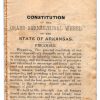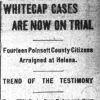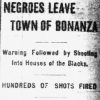calsfoundation@cals.org
Nevada County Race War of 1897
On May 29, 1897, white employees of the Sayre Lumber Company near Prescott (Nevada County) set fire to a cabin where ten of the company’s African-American workers were sleeping. When the Black laborers attempted to flee, the mob fired shots at them. No one was killed, and, due to the diligence of a private detective, indictments were actually brought down in the case (although the accused were eventually acquitted).
According to the New York Times, “bad blood had existed among the white and colored laborers of the lumbering district of that section for some time past, and frequently efforts have been made by the employees of the Nevada County camps to run the negroes off, but always without avail.” On the night of May 29, in what the Times called a “horrible case of butchery,” a gang of “armed, half-drunken toughs” surrounded the cabin in which the ten Black workers were sleeping. They set it on fire, all the while shooting their guns and “rendering the night hideous with their curses.” The Black workers remained in the cabin until the roof started to fall on them and then tried to run outside. The gang fired more shots, wounding four. The other six escaped. The mob then dispersed, leaving the injured without medical attention until the following morning.
Fearful of arrest, the arsonists posted notices across the county “warning the public not to attempt prosecution of the desperadoes under penalty of death and destruction of property.” Concerned white citizens of the county, however, sent to Little Rock (Pulaski County) for detectives to investigate the incident. According to the Arkansas Gazette, by July 24, Detective W. A. Clay had returned following a two-month investigation into the case. On the basis of his evidence, Deal Beck, Willis Beck, Tom Johnson, and Allen Sherry were indicted for arson and assault with attempt to kill. Most of the newspapers described the accused as transient laborers, not permanent citizens of the county. In fact, the Gazette made a very clear statement that what they did was “not chargeable to the citizens of Nevada County.” According to the Idaho Daily Statesman, they were “members of a gang of white men who have been waging relentless warfare on negroes in the lumber districts of South Arkansas.” The Becks were said to have prior records, and the Kansas City Journal went so far as to say that all the transient workers in the county “have bad reputations.” Whatever the case, the African Americans in the area got the message, “and those who had been warned to leave lost no further time in taking their departure.”
The four accused were acquitted of all charges in January 1898 in the Nevada County Circuit Court, the judge citing “unreliable evidence.” Though the newspapers had described the accused as transient laborers when initially indicted, the tone of the reporting changed upon acquittal, with Deal Beck, the reputed leader of the group, being described as “a good and highly respected citizen and a property owner.”
For additional information:
“The Beck Family.” Arkansas Gazette, January 22, 1898, p. 3.
“Outlaws Indicted.” Idaho Daily Statesman, July 26, 1897, p. 2.
“Race Riot in Arkansas.” New York Times, July 26, 1897, p. 1.
“Result of a Race War.” Kansas City Journal, July 26, 1897, p. 2
“Whites vs. Blacks.” Arkansas Gazette, July 25, 1897, p. 2.
Nancy Snell Griffith
Presbyterian College





 Nevada County Race War Article
Nevada County Race War Article 



Comments
No comments on this entry yet.